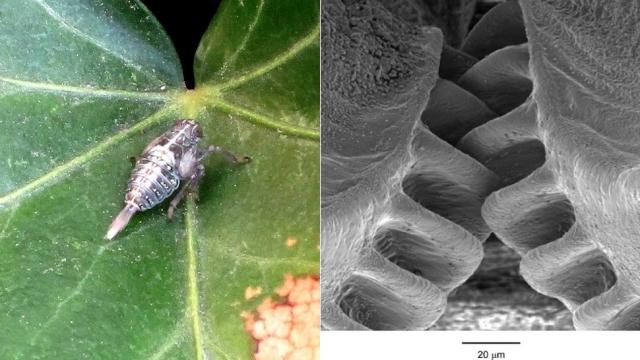When you think of the fastest accelerators in the animal kingdom, large, muscular mammals will probably be the first that come to mind. But steady among them is the inconspicuous adolescent issus, who can hit an acceleration of 400 gs in 2 milliseconds flat (humans lose consciousness over 5 gs) — all thanks to what scientists have now identified as the first biological set of gears ever discovered.
Not only can the issus can hit an acceleration over 20 times what a normal human body can handle, but this insect’s jump breaks 8 mph — faster than you can blink. Not bad for a bug that’s just a tenth of an inch long. But how did this itty bitty issus develop its very own set of gears? Since the issus is most commonly found in European climbing ivy, airborne predators can easily make their way over come lunchtime, so it behooved the potential bird-food to jump as high and quick as their little legs could carry them. Which, apparently, means gears.
As Malcolm Burrows explained to Popular Mechanics:
Jumping is one of the most rapid and powerful things an animal can, do and that leads to all sorts of crazy specialisations. You can imagine being at the top of the thigh bone in a human. As the legs unfurl to power the jump both have to move at exactly the same time. If they didn’t, the animal would start to spiral out of control.
When we jump, we depend on our nervous system to tell our legs how to stay together in a constant feedback and adjustment loop. The issus, however, doesn’t play that game. Their tiny gears get going and lock together, so their legs will remain safely in that position before their brains can even register what’s going on.
One of the coolest things about this discovery, though, is that nature may have just inspired us with an entirely new gear design. The teeth of the issus’ little leg gears are almost shaped like “cresting waves,” which is markedly different from any gear teeth wrought of human design. On the one hand this could be a completely random choice in the limitless number of possible shapes. On the other, though, this specific tooth-shape might have come from a preference towards speed in one direction only. And as Gregory Sutton, a coauthor of the paper and insect researcher at the University of Bristol, told Popular Mechanics, “It’s a prototype for a new type of gear.”
It’s only the adolescent (re: tween) version of the insect that has these gears, though. As they leave behind the trifles of childhood, the issus molts its exoskeleton several times until finally reaching a full-grown, gear-less adult size. They then simply uses friction just like every other plant-hopping insect. Researchers believe this may be because, should a gear break in an adult insect, they’d be stuck with the broken gear for the rest of their — at that point probably short — life. In an issis tween, however, broken gears will simply eventually be shed.
But even if just for that short amount of time, these gears can give the issus the ride of their life — and maybe one day, the ride of ours. [Popular Mechanics]
